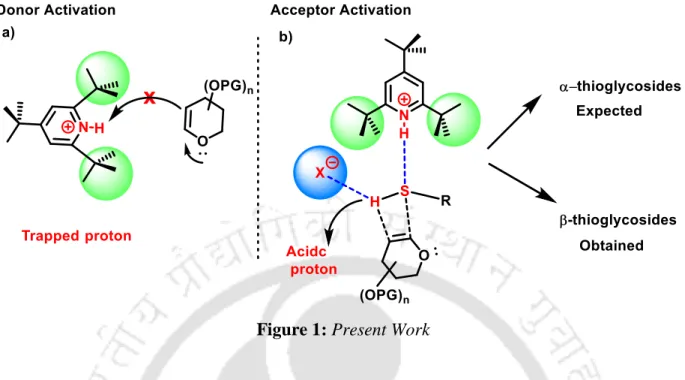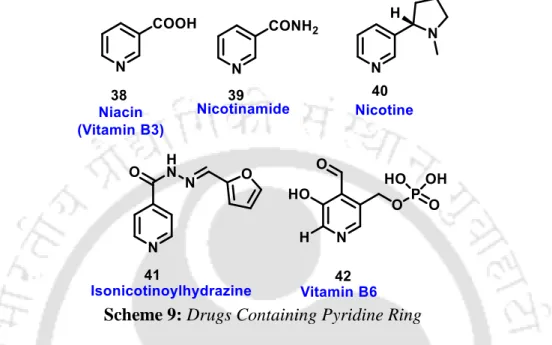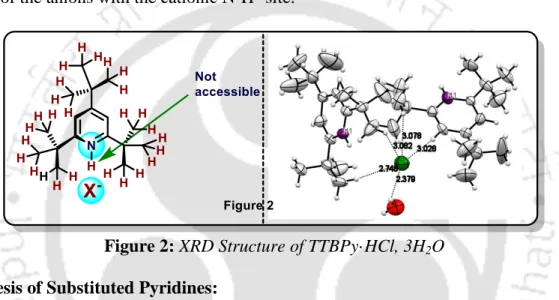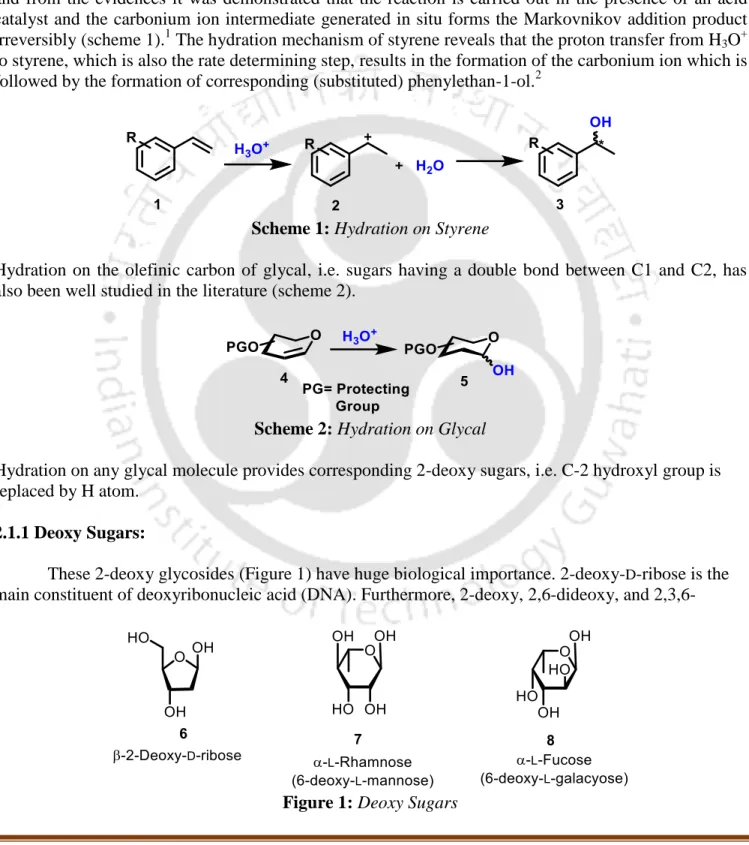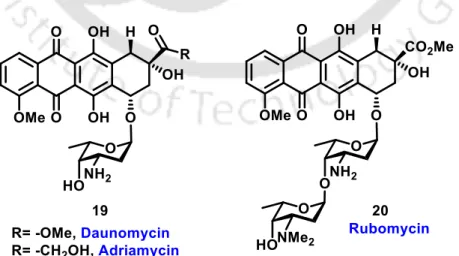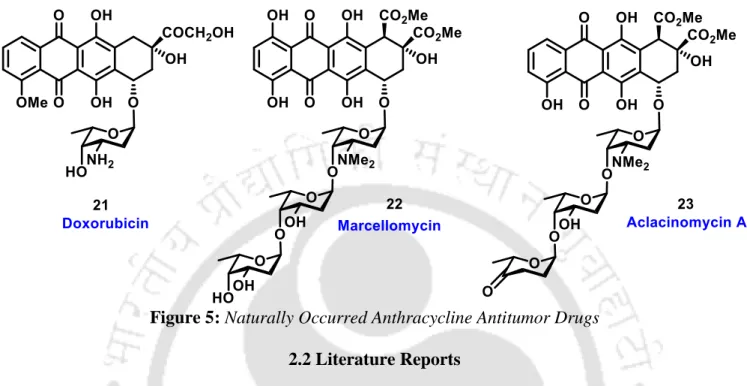Sterically Strained Brønsted Pair Catalysis by Bulky Pyridinium Salts: Direct Stereoselective Synthesis of 2-Deoxy and 2,6- Pyridinium Salts: Direct Stereoselective Synthesis of 2-Deoxy and 2,6-Dideoxy-β-thioglycosides from Glycals. Sterically Strained TTBPy·HCl Catalyzed Direct Stereoselective Synthesis of 2- Deoxy and 2,6-dideoxy-β Thioglycosides from Glycals.
Influence of Various Silyl Protecting Groups on the Stereo- Selectivity of Rhamnosylation: Stereoselective Synthesis of OTBDPS
There are very few literature reports on sulfonamidoglycosylation, and all the synthesized molecules are not previously known in the literature. ESR studies provided evidence for the potential involvement of the frustrated radical pair intermediates in the present protocol.
Sterically Strained Brønsted Salts and Their Utility
Literature Survey on Glycosylation Reaction .1 Carbohydrates
- Basics of Chemical Glycosylation
- Factors Affecting Glycosylation Reaction 1.2 Literature Survey on Bulky Pyridine Derivatives
Utility of Sterically Strained Pyridine Derivatives in Various Organic Reactions 1.5 Utility of Sterically Strained Pyridine Derivatives in Glycosylation Reactions
Sterically Strained Pyridinium Salts and Their Utility as Organocatalyst in Various Glycosylation Reactions
Conclusion and Summary 1.8 References
Introduction
- Deoxy Sugars 2.1.2 2,6-Dideoxy Sugars
- Biological Importance of Deoxy Sugars
- Literature Preview on Organocatalytic Stereoselective Synthesis of 2-Deoxy Glycosides
- Initial Studies on Deoxy Sugar Hemi-acetal Synthesis 2.3 2-Deoxy Trehalose Sugar
Silyl Protected Deoxy Sugar Synthesis 2.5 Optimisation Study
Results and Discussion
- Scope of Various 2-Deoxysugar and 2-Deoxy Trehalose Derivatives with Different Glycosyl Donors
- Control Experiments 2.6.3 NMR Experiments
- Gram Scale Synthesis of Compound 3h
Application of Synthesized 2-Deoxyhemiacetals in Several Other Reactions .1 Literature Preview on α-Selective Synthesis of 2-Deoxy Glycosides
- Other Reactions of Anomeric Hemiacetals 2.8 Conclusion
Experimental Section 2.10 References
Spectra
Introduction
- Thiolation on Terminal Olefin 3.1.2 Thioglycosides
This Work
Results and Discussion
- Optimization Studies 3.3.2 Scope of Derivatives
Conclusion
Experimental Section 3.7 References
NMR, IR, ESR Studies
- NMR Titration Experiments
- Study of the N-H Stretching Frequency of TTBPy·HCl from IR Spectroscopy 3.8.3 ESR Study
Spectra
Large Scale Synthesis of 4a
Synthesis of Unprotected Thioglycosides 3.12 nOe Experiments
Assignment of Stereochemistry
Introduction 4.2 Literature Reports
- Addition of Sulfonamides to Terminal Alkenes 4.2.2 Sulfonamidoglycosylation
- Sulfonamidoglycosylation on Deoxy Sugars 4.3 Results and Discussion
- Optimization Studies
- Control Experiments 4.4 IR and EPR Studies
- Study of the N-H Stretching Frequency of TTBPy·HCl from IR Spectroscopy 4.4.2 ESR Study
Applications 4.6 Failures
Experimental Section 4.9 Reference
Spectra
Assignment of Stereochemistry
Introduction
- Importance of 2-Deoxy and 2,6-Dideoxy Glycosides 5.2 Previous Reports
- Literature Reports on Synthesis of 2,6-Dideoxy Glycosides
- Literature Reports on Stereoselective Synthesis of Silyl Protected 2,6-Dideoxy Glycosides
Results and Discussion
- Rhamnosylation of Anomeric Acetate Donors with O-, S- and C- Acceptors 5.3.2 Protecting Group Effect on Rhamnosylation
Synthesis of Trisaccharide 5.6 Conclusion
Experimental Section
Spectra
Carbohydrates are generally available as an immediate source of energy, and it is one of the most abundant molecules on earth, occupying up to 75% of biomass.
Carbohydrate-Based Molecules in Medicinal Chemistry
General Scheme for O-Glycosylation
Commonly Used Glycosyl Donors
Glycosyl Acceptors
Monosaccharide and Oligosaccharide 1.1.3 Factors Affecting Glycosylation Reaction
On the other hand, in the case of β-anomer, these two dipoles act in the same direction, i.e. In the case of β-anomer, the lone pairs of electrons on the oxygen are coplanar with the heteroatom attached to the anomeric center, giving rise to 1,3 interaction.
General Representation of Neighbouring Group Participation
- Literature Survey on Bulky Pyridine Derivatives
They have reported that trans-2,3-cyclic carbonates deactivate the anomeric center of thioglycoside donors both electronically and conformationally (Scheme 7, compound 33). In addition, they have shown that 3,4-di-tert-butyl-disiloxane-protected donor shows disarming effect (Scheme 7, compound 34).11.
Drugs Containing Pyridine Ring
This effect can only be explained by considering the poor solvation of the protonated pyridinium cation. It is evident that the reactivity of TTBPyH+ in various organic reactions is largely dependent on the hydrogen bonding properties of the reaction solvent.
Cyclo-trimerization of Alkynes
The remarkable ability of tri-tert-butylpyridine to differentiate between Bronsted and Lewis acids is one of the classic examples of the influence of sterics on changing reactivity. Typically, the size of the TTBPyH+ cavity does not allow any hydrogen bonding interactions (Figure 2) of the anions with the N-H+ cationic site.20.
Hantzsch Pyridine Synthesis
Synthesis of TTBP
Synthesis of DTBP
- Utility of Sterically Strained Pyridine Derivatives in Various Organic Reactions
Acylation of an Aromatic Compound in the Presence of TTBPy
According to recent observations by Berke and co-workers, bulky TTBPy can exhibit frustrated Lewis pair (FLP) reactivity in the presence of B(C6F5)3 or [(acridine)BCl2][AlCl4] and can heterolytically cleave H2 (Scheme 16).29,30 Interestingly , that Ingleson and co-workers observed that the hydride position from H2 was found to be the C9 position of acridine, as opposed to the normally expected boron.
Heterolytic Cleavage of Hydrogen by FLP
- Utility of Sterically Strained Pyridine Derivatives in Glycosylation Reactions
Activation of Hemiacetal in the Presence of TTBPy/sulfoxide Catalytic System
TTBPy salts were synthesized with various counter anions such as hydrochloride, hydrobromide, iodide, triflate and BArF4 as shown in the general scheme (Scheme 19).
Catalyst Synthesis
O-Glycosylation using TTBPy·HX Catalysis
- Conclusion and Summary
- References
This results in the formation of the oxocarbenium ion which is then captured by the alkoxide ion bound to TTBPyH, giving rise to the observed product and also regeneration of the catalyst. The following chapters in this thesis are also based on the exploration of the bulky 2,4,6-tri-tert-butylpyridinium salts as organocatalysts for C-O, C-S and C-N bond-forming reactions in carbohydrate chemistry.

Hydration on Styrene
C−H··· Anion Interactions Assisted Addition of Water to Glycals by Sterically Hindered 2,4,6-Tri-tert-Butylpyridinium Hydrochloride 2,4,6-Tri-tert-Butylpyridinium Hydrochloride. There are sufficient studies on the hydration of olefin-terminal styrene and substituted styrene, and the data showed that the reaction is carried out in the presence of an acid catalyst and the carbon ion intermediate generated in situ forms the Markovnikov addition product irreversibly ( scheme 1).1 The mechanism of styrene hydration reveals that proton transfer from H3O+ to styrene, which is also the rate-determining step, results in the formation of the carbon ion, which is followed by the formation of the corresponding phenylethane-1 ( replaced). ol. 2.
Hydration on Glycal
- Deoxy Sugars
- Literature Preview on Organocatalytic Stereoselective Synthesis of 2-Deoxy Glycosides Catalysis in which the rate of the chemical reaction is increased by an organic molecule is
2-Deoxysugars: One of the most important 2-deoxysugars is 2-deoxy-D-erythro-pentose (2-deoxyribose), the main component of deoxyribonucleic acids (DNA). These are one of the most abundant carbohydrates in nature and they have antibiotic and anti-tumor activity.
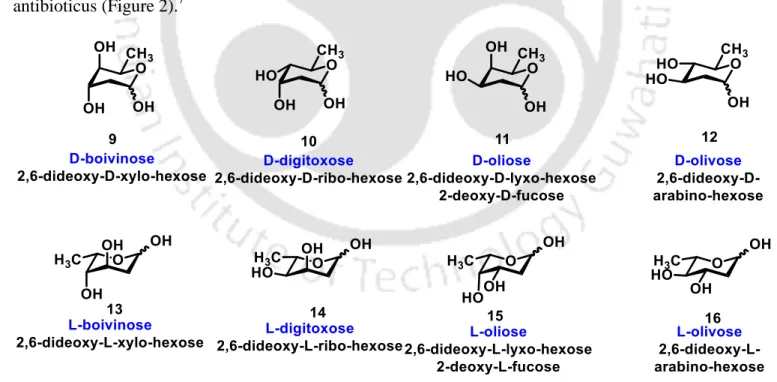
Organoboron-Catalyzed Synthesis of β-2-Deoxyglycosides
They selected gluco-, galacto-, and rhamno-based per-acetate donors and converted them into anomeric chloride. The thus obtained anomeric chloride was then reacted with cis-1,2- and 1,3-diol acceptors using an organo-boron catalyst in the presence of Ag2O (scheme 4).16 In this method they were in able to synthesize partially protected disaccharides with regio- and β-stereoselectivity.
Cyclopropenium Cation Promoted Dehydrative Glycosylations
Schreiner′s Thiourea Catalysed Glycosylation
Koenigs−Knorr activation of Glycosyl Chlorides
TTBPy·HCl Catalysed Glycosylation
Secondary Amine Salts Catalysed Glycosylation 2.2.2 Initial Studies on Deoxy Sugar Hemi-acetal Synthesis
Synthesis of 2-Deoxysugar in the Presence of 8 M HCl
- Silyl Protected Deoxy Sugar Synthesis
Biao Yu and co-workers proposed a dehydrative glycosylation method that explains the activation of glycosyl hemiacetals using nonafluorobutanesulfonyl fluoride (NfF) as a catalyst.26 They have shown that in the absence of any acceptor, self-condensation of the glycosyl hemiacetal takes place. which give the corresponding symmetrical 1,1'-dimer or trehalose molecules in high yields. Self-condensation product or dimerized product is a very commonly expected by-product in the dehydrative glycosylation method, since 2-deoxylactols have a high tendency to self-condense the substrates.
Application of Literature Methods of Hemiacetal Synthesis
Silencing protecting groups occupy an important position in synthetic organic chemistry 27 and even more so in carbohydrate chemistry. 28 , 29 It is well established that silyl protecting groups, which generally require a large steric space and thus impose a conformational constraint, offer better anomeric selectivities in glycosylation reactions. 28, 20 However, the influence of silyl protecting groups in the chemistry of 2-deoxysugars, versatile intermediates in carbohydrate chemistry, has been understudied due to difficulties in the synthesis of 2-deoxy-hemiacetal precursors. The NIS-ACN25a method can provide sugar lactols in the presence of acid-sensitive silyl protecting groups, but with an undesired 2-iodo substitution that requires an additional removal step (Scheme 16).
NIS-ACN Method of Hemiacetal Synthesis
- Optimisation Study
- Scope of Various 2-Deoxysugar and 2-Deoxy Trehalose Derivatives with Different Glycosyl Donors
When the catalytic loading was decreased to 10 and 5 mol %, respectively (Table 1B, entries 2 and 3, respectively), the percentage conversion to hemiacetal 50c also dropped to 54% and 50%, respectively, a possible increase in the percentage of 2-deoxy trehalose 51a was observed. Interestingly, when the reaction was carried out at 40 °C by reducing the catalyst loading to 2 mol %, the exclusive formation of hemiacetal 50c was achieved in high yield ( Table 1B , entry 4).

Silylated 2-deoxysugars from glycals
On the contrary, with a catalytic loading of 10 mol % at room temperature and with reduced water content in the solvent mixture of 99:1, we were able to change the product distribution to give 88% of the 2-deoxytrehalose derivative 51a (Table 1B, entry 7). With the optimized conditions in hand, for both the synthesis of silyl-protected hemiacetals and the 2-deoxytrehalose derivatives, we tested the substrate scope with different silyl-protected glycals.
Silylated 2-Deoxysugar Dimers from Their Respective Glycals
- Control Experiments
- NMR Experiments
- IR Studies
- Gram Scale Synthesis of Compound 50h
The increased acidity of the protons of the water molecule allows the protonation of glycals. It has been observed that the chemical shifts of the signals from the non-exchangeable ring protons of the pyridine as well as alkyl group signals were affected by increasing concentrations of water.
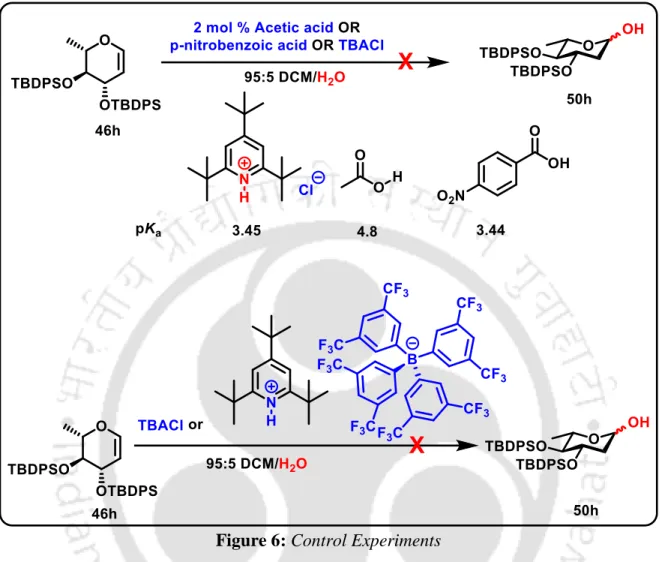
Gram Scale Synthesis
- Application of Synthesized 2-Deoxyhemiacetals in Several Other Reactions
- Stereoselective Glycosylations of Silyl-Protected Hemiacetals via Secondary Amine Catalysis The synthetic utility of the thus synthesized hemiacetals was showcased in accessing α-selective
The broadening of the signals in the 1H NMR spectra corresponding to the aromatic protons together with the ortho-tert-butyl protons in solution state could arise from the strong C-H···Cl-···H-O-H interactions occurring even in the solid state can be observed. All of these observations also reiterate the fact that the sterically protected N−H proton is not involved in any exchange process or transfer of a proton to a water molecule that gives rise to the hydronium ions.43-45.
Stereoselective Glycosylations of Silyl-Protected Hemiacetals via Secondary Amine Catalysis
Reaction condition: 1.1 equivalents of the acceptor were used in the case of monosaccharide (55k) and 1.5 equivalents of the acceptor (57a-d) were used in the case of disaccharides (55a-j) synthesis.
Proposed Mechanistic Pathway for Glycosylation Reaction 2.7.2 Equilibrium Anomeric Ratio of Various Donors
- Other Reactions of Anomeric Hemiacetals
The change in the anomeric ratio was monitored by 1H-NMR at an interval of 5 hours and then at 3 hours. Moreover, the mismatch of the anomeric selectivities obtained in the catalysis of the secondary amine with the thermodynamic anomeric equilibrium ratios of the hemiacetals points to the kinetic origin of the products in this catalysis.
Other Reactions of Anomeric Hemiacetals
- Conclusion
- Experimental Section General Information
- References
- nOe Experiment of 56aα
- XRD Data
Moreover, the thus synthesized hemiacetals were again used in mechanistically distinct secondary amine catalysis for the stereoselective synthesis of various glycosides. The anomeric hemiacetals have also been successfully used in the synthesis of O-arylated glycosides via a copper-catalyzed addition of phenylboronic acids. The organocatalytic hydration of glycals presented here in combination with the iminium-catalyzed stereoselective glycosylation provides a practically straightforward approach for the synthesis of oligosaccharides and various other carbohydrate synthons.
Repurification was performed by HPLC (retention time - 6 min, solvent - HPLC grade acetonitrile, flow rate - 5 ml/min). Repurification was performed by HPLC (retention time - 7 min, solvent - HPLC grade acetonitrile, flow rate - 5 ml/min). Repurification was by HPLC (retention time - 8 min, solvent - HPLC grade acetonitrile, flow rate - 5 ml/min).
Sterically strained Brønsted pair catalysis with bulky pyridinium salts: Direct stereoselective synthesis of 2-deoxy and 2,6-dideoxy-β-thioglycosides from.
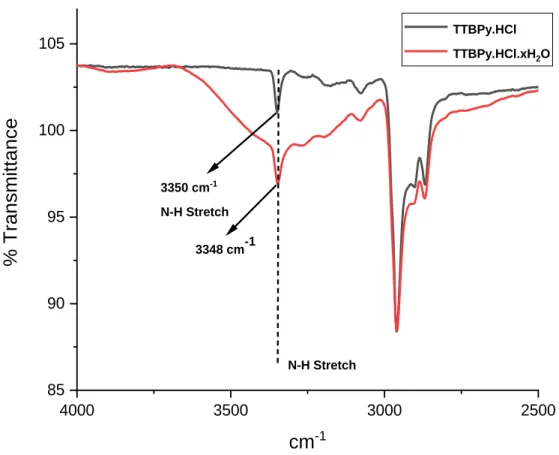
Sterically Strained Brønsted Pair Catalysis by Bulky Pyridinium Salts: Direct Stereoselective Synthesis of 2-Deoxy and 2,6-Dideoxy-β-thioglycosides from
Thiolation on Terminal Olefin
Thiol-ene Reaction
Gold-Catalyzed Anti-Markovnikov Selective Hydrothiolation
Click Reaction 3.1.2 Thioglycosides
Glycosylation with Glycal Donor
Jayaraman and co-workers developed a new method to synthesize 2-deoxy-1-thioglycosides from glycals using ceric ammonium nitrate as a catalyst. They proposed that the reaction proceeds via the formation of oxocarbenium radical ions and also predicted that the process is mediated by thiolate intermediates (Scheme 6).7.
Ceric Ammonium Nitrate Mediated Synthesis of 2-Deoxy-1-Thioglycosides Zhu and co-workers have developed an exquisite procedure to synthesize both α and β
Stereoselective Synthesis of S-Linked 2-Deoxy Sugars
Following the successful use of large-scale ion pair catalysis in the synthesis of 2-deoxy O-glycosides in Chapter-II,10 we report here the first organocatalytic synthesis of a 2-deoxy-thioglycoside directly from glycals. Evidence for the involvement of a frustrated radical pair in Brønsted pair catalysis was also found for the first time (Scheme 9).
This Work
- Optimization Studies
- Scope of Derivatives
- Control Experiments
- Mechanistic Studies
- Proposed Mechanism
- Experimental Section
- References
- Study of the N-H Stretching Frequency of TTBPy·HCl from IR Spectroscopy
- ESR Study
We found that the reaction proceeds extremely well, with 5 mol% of the catalyst giving rise to the product in 79% yield in 3 h (Table 1, entry 2), and the change in catalytic mol% did not affect the selectivity. However, it can also be argued that the H-bonding ability of cationic [TTBPyH]+ is further diminished in the presence of the bulky anions. ESR studies provided evidence for the potential involvement of the exciting frustrated radical pair intermediates in the present protocol.
In addition, the stereochemistry of some of the known compounds has also been matched with the literature reports. The mixtures were stirred in the sealed flask until the reaction was determined to be complete by either TLC or NMR analysis of the crude material. HPLC retention time for the β-isomer - 11 min (solvent HPLC grade acetonitrile, flow rate - 5 ml/min).
HPLC retention time of the α isomer- 13 min (solvent - HPLC grade acetonitrile, flow rate - 5 ml/min).
